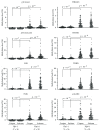Noncoding Genomics in Gastric Cancer and the Gastric Precancerous Cascade: Pathogenesis and Biomarkers
- PMID: 26379360
- PMCID: PMC4563069
- DOI: 10.1155/2015/503762
Noncoding Genomics in Gastric Cancer and the Gastric Precancerous Cascade: Pathogenesis and Biomarkers
Abstract
Gastric cancer is the fifth most common cancer and the third leading cause of cancer-related death, whose patterns vary among geographical regions and ethnicities. It is a multifactorial disease, and its development depends on infection by Helicobacter pylori (H. pylori) and Epstein-Barr virus (EBV), host genetic factors, and environmental factors. The heterogeneity of the disease has begun to be unraveled by a comprehensive mutational evaluation of primary tumors. The low-abundance of mutations suggests that other mechanisms participate in the evolution of the disease, such as those found through analyses of noncoding genomics. Noncoding genomics includes single nucleotide polymorphisms (SNPs), regulation of gene expression through DNA methylation of promoter sites, miRNAs, other noncoding RNAs in regulatory regions, and other topics. These processes and molecules ultimately control gene expression. Potential biomarkers are appearing from analyses of noncoding genomics. This review focuses on noncoding genomics and potential biomarkers in the context of gastric cancer and the gastric precancerous cascade.
Figures





References
-
- Forman D., Bray F., Brewster D. H., et al. Cancer Incidence in Five Continents. Vol. 10. International Agency for Research on Cancer; 2013.
-
- Lui F. H., Tuan B., Swenson S. L., Wong R. J. Ethnic disparities in gastric cancer incidence and survival in the USA: an updated analysis of 1992-2009 SEER data. Digestive Diseases and Sciences. 2014;59(12):3027–3034. - PubMed
Publication types
MeSH terms
Substances
LinkOut - more resources
Full Text Sources
Other Literature Sources
Medical

